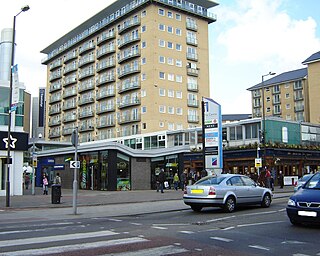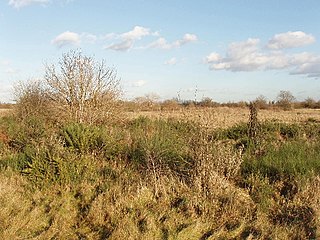
Brentford is a suburban town in West London, England and part of the London Borough of Hounslow. It lies at the confluence of the River Brent and the Thames, 8 miles (13 km) west of Charing Cross.

Feltham is a town in West London, England, 13 miles (21 km) from Charing Cross. Historically part of Middlesex, it became part of the London Borough of Hounslow in 1965. The parliamentary constituency of Feltham and Heston has been held by Labour Party MPs since 1992. In 2011, the population of the combined census area of Feltham, Bedfont and Hanworth was 63,368.

Hounslow Heath is a local nature reserve in the London Borough of Hounslow and at a point borders Richmond upon Thames. The public open space, which covers 200 acres (80 ha), is all that remains of the historic Hounslow Heath which covered more than 4,000 acres (1,600 ha). The present day area is bounded by A315 Staines Road, A3063 Wellington Road South, A314 Hanworth Road, and the River Crane.

The Military Museums is a reorganization of the former Museum of the Regiments in Calgary, Alberta, announced by Sophie, Countess of Wessex, on June 3, 2006. The new museum comprises the former Museum of the Regiments as well as the relocated Naval Museum of Alberta and an Air Force Wing consisting of artifacts being acquired.

The Gas Light and Coke Company, was a company that made and supplied coal gas and coke. The headquarters of the company were located on Horseferry Road in Westminster, London. It is identified as the original company from which British Gas plc is descended.

Isleworth Cemetery is a cemetery in Isleworth, London Borough of Hounslow, in west London, England.

William Robert Colton was a British sculptor. After completing his studies in London and Paris, Colton established himself with solid, career-long business relationships, secured admission to exhibitions at the Royal Academy and the Salon in Paris. His works included commissions for busts, statues and war memorials. His clientele included royalty in England and India.

Southall Gas Works is a former gas works site of around 88 acres (36 ha) in Southall, west London, which is currently being redeveloped for mixed-use including 3,750 homes as part of Berkeley Group's The Green Quarter.

The Livesey Hall War Memorial, in Lewisham, Greater London, commemorates the fallen of World War I and World War II who had been employed by the South Suburban Gas Company of London. It is also a tribute to those employees who served in the wars. The monument was designed and executed by the British sculptor Sydney March, of the March family of artists.

The Royal Fusiliers War Memorial is a memorial in London, dedicated to the members of the Royal Fusiliers killed in the World Wars, Russian Civil War and subsequent conflicts, along with members of a number of London Regiment battalions killed in the First World War. It consists of a bronze statue on a 16.5 feet (5.0 m) pedestal made of Portland stone.

Thomas Henry Nowell Parr FRIBA was a British architect, best known for designing pubs in west London. Many of these were built while Parr was "house architect" for Fuller's Brewery. Parr designed various buildings in Brentford while he was surveyor and then architect to the Council from 1894 to 1907.

Brentford Baths is a Grade II listed building at Clifden Road, Brentford, in the London Borough of Hounslow.

Anning Monument is a heritage-listed memorial at the corner of Hemmant and Tingalpa Road and Boonoo Street, Hemmant, City of Brisbane, Queensland, Australia. It was designed and built by William Busby in 1903. It is also known as Hemmant Boer War Memorial. It was added to the Queensland Heritage Register on 21 October 1992.

Finchley War Memorial is located in Ballards Lane, North Finchley, outside the United Services Club. It was unveiled by Viscount Lascelles on the 13th November 1925, an event that was attended by thousands of people. The memorial is dedicated to 1,000 servicemen and women from Finchley who died in World War I. After the ceremony, dignitaries addressed a tightly packed gathering in the St Kilda Hall. Finchley sent over five thousand men to the Colours. Finchley United Services Club

The Royal Artillery Boer War Memorial is located on the south side of The Mall in Central London, close to the junction with Horse Guards Road at the northeast corner of St James's Park. Unveiled in 1910, it marks the deaths of the 1,083 soldiers of the Royal Artillery who died in the Second Boer War from 1899 to 1902 It has been a listed building since 1970.

The Bromley-by-Bow gasholders are a group of seven cast iron Victorian gasholders in Twelvetrees Crescent, West Ham and named after nearby Bromley in the London Borough of Tower Hamlets.

Streatham War Memorial is a war memorial to the war dead of the London district of Streatham in the two World Wars. It was unveiled in 1922, and is sited near the northwest corner of Streatham Common, London Borough of Lambeth, England.
Railway war memorials are memorials dedicated to railway company employees killed in war. Some were commissioned by the railway companies while others were commissioned on behalf of the employees. Such memorials were first erected after the Second Boer War (1899–1902), though the vast majority appeared after the First World War. Over 400 railway war memorials are known to exist in Britain, ranging from paper rolls of honour to imposing stone monuments. Some have been destroyed or lost through multiple changes in ownership or redevelopment of their surroundings. The Railway Heritage Trust and Network Rail maintain a database of the known surviving memorials.


















